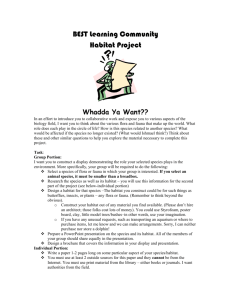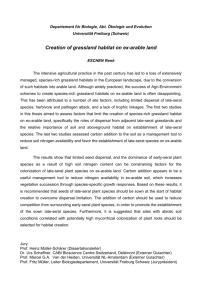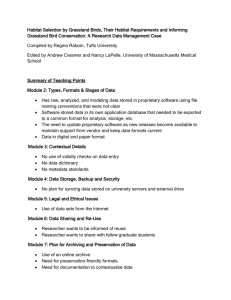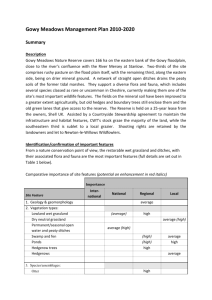Teacher Notes (2.88 MB DOC)
advertisement
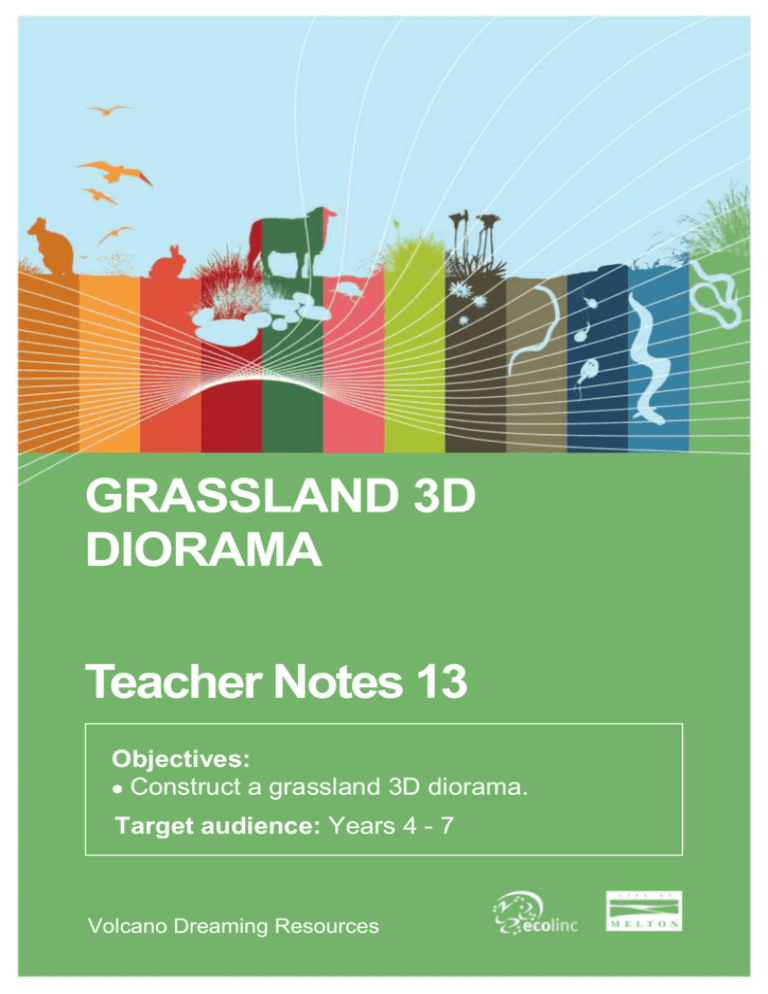
GRASSLAND 3D DIORAMA Teacher Notes 13 Objectives: Construct a grassland 3D diorama. Target audience: Years 4 - 7 Volcano Dreaming Resources Teacher Notes 13 Grassland Diorma 1 Duration One 50-minute session Materials Student worksheet Pencil BWVP Grassland Cutouts (printed, one set per student), (paper size suggestion): o Ecolinc building instructions – print A4 o Ecolinc building art – print A3 o Ecolinc map cut out – print A3 o All animals and plants – print A3 or A4 One per student of the following: o Scissors o Ruler o Scalpel (ensure teacher supervision when using) o Cutting board o Sticky tape o Green straw (cut to 9 cm) Class set of computers with access to the internet. Students need to open: o Ecolinc BWVP Flora and Fauna Field Guide Activity This activity is an extension to the Volcano Dreaming unit of work. Teachers may choose to use this as an assessment task to determine the students’ level of understanding about grasslands and wetlands. Students will make a 3D model of a grassland and wetland and place 3D animals and plants in an appropriate location depending on their habitat requirements. Teacher Notes 13 Grassland Diorma 2 Carrying out the activity 1. Discuss what makes a successful ecosystem. Answers should include living components, such as producers, consumers, scavengers/decomposers, and non-living components such as sun, air, water, nutrients, sand, dead sticks, rocks, etc. 2. Students will construct a 3D model of the two Ecolinc ecosystems, a grassland and wetland, which includes the habitat, plants and animals. Initially, students will construct the Ecolinc building by following the instructions outlined in the ‘Ecolinc building instructions’, using the ‘Ecolinc building art’ and the ‘Ecolinc map cut-out’. 3. Secondly, students follow the instructions to create the 3D animals and plants. 4. Students use the Ecolinc BWVP Flora and Fauna Field Guide to identify the habitat for each animal and plant. Locate and place the 3D animals and plants in an appropriate position on the Ecolinc map. 5. Students complete the discussion questions and discuss their findings with their peers, then complete the conclusion questions. Teacher Notes 13 Grassland Diorma 3 Student activity You will construct a 3D model of the ecosystems found at Ecolinc, complete with 3D animals and plants. 1. Follow the ‘Ecolinc building instructions’, using the ‘Ecolinc building art’ and the ‘Ecolinc map cutout’ to complete the 3D Ecolinc building and grounds. 2. Follow the instructions on the individual organisms to create the 3D animals and plants. 3. Write the names of all the animals and plants in the correct columns below. Using the Ecolinc BWVP Flora and Fauna Field Guide, identify habitat requirements for each animal and plant. Animal Habitat Blue Tongue (Common Blue-tongue Lizard) Basalt plains and urban areas. Crimson Rosella Tall eucalypt and wetland forests, also includes heavy wet forests, inland river belt areas and mallee areas. Eastern Barred Bandicoot Tall, dense native grassland and grassy woodland. Growling Grass Frog Well-vegetated ditches, dams and swamps. Australian Magpie Eucalypt woodland close to tree-lined rivers. White-faced Heron Sea-coasts, marshes, lakes, flooded fields. White Plumed Honeyeater No data available on Field Guide. Open forests and woodlands. Plant Habitat Kangaroo Grass Grasslands and grassy woodlands. River Red Gum Grassy woodlands with moist soil. 4. Position the plants and animals on the Ecolinc landscape in the most appropriate location. 5. Identify the habitats found at Ecolinc. A wetland and grassland are the habitats found at Ecolinc. 6. What does a habitat need to provide animals? A habitat must provide shelter from weather and predators, food and water, and space to raise young. Teacher Notes 13 Grassland Diorma 4 Conclusion 7. Define habitat. A habitat is a place or an environment where a plant or animal naturally lives and grows. 8. What is needed for a successful ecosystem? Successful ecosystems are made up of living and non-living components. Living components include producers, consumers and scavenges/decomposers. Non-living components include sun, air, water, nutrients, dead sticks, rocks, etc. 9. Choose one animal or plant and discuss its habitat requirements in detail. Answers will vary. 10. You chose to position the plants and animals according to their habitat requirements. Could the plants and animals be positioned in a different habitat? Plants and animals generally live in the specified habitat, as they have adapted to the conditions. This habitat will provide suitable shelter, food, water and reproductive needs. If the habitat changes it might no longer be suitable. 11. Using the Ecolinc BWVP Flora and Fauna Field Guide, list additional animals that could be added to your 3D grassland model. Identify the habitat of each. Answers will vary.

